Toyota Corolla (E120) 2002–2008 Repair Manual / Power steering / Power steering system / On–vehicle inspection
Toyota Corolla (E120): On–vehicle inspection
1. Inspect drive belt
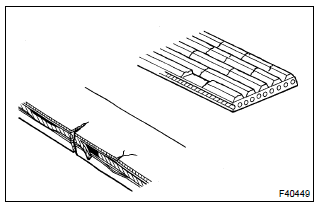
- Visually check the belt for excessive wear, frayed cords, etc.
If any defect is found, replace the drive belt.
Hint
: cracks on the rib side of a belt are considered acceptable. If the missing chunks from the ribs are found on the belt, it should be replaced.
2. Bleed power steering system
- check the fluid level.
- jack up the front of the vehicle and support it with the stands.
- turn the steering wheel.
- With the engine stopped, turn the wheel slowly from lock to lock several times.
- lower the vehicle.
- start the engine.
- Run the engine at idle for a few minutes.
- turn the steering wheel.
- With the engine idling, turn the wheel to left or right full lock position and keep it there for 2 – 3 seconds, then turn the wheel to the opposite full lock position and keep it there for 2 – 3 seconds.
- Repeat (1) several times.
- stop the engine.
- check for foaming or emulsification.
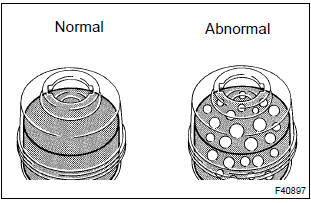
Especially, if the system has to be bled twice because of foaming or emulsification, check for fluid leaks in the system.
- check the fluid level.
3. Check fluid level
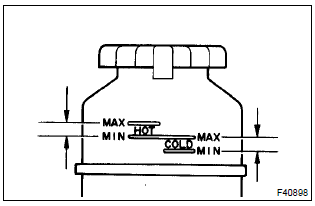
- Keep the vehicle level.
- with the engine stopped, check the fluid level in the oil reservoir.
If necessary, add fluid.
Fluid: atf dexron® ii or iii
Hint
: check that the fluid level is within the hot level range on the reservoir tank. If the fluid is cold, check that it is within the cold level range.
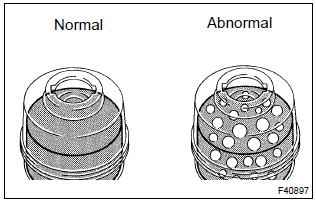
- Start the engine and run it at idle.
- turn the steering wheel from lock to lock several times to
raise fluid temperature.
Fluid temperature: 75 – 80°c (167 – 176°f)
- check for foaming or emulsification.
If foaming or emulsification is identified, bleed the power steering system.
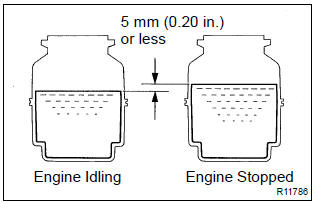
- With the engine idling, measure the fluid level in the oil reservoir.
- stop the engine.
- wait a few minutes and measure the fluid level in the oil
reservoir again.
Maximum fluid level rise: 5 mm (0.20 In.) If a problem is found, bleed the power steering system.
- check the fluid level.
4. Check steering fluid pressure
- disconnect the pressure feed tube from the ps gear .
- connect sst, as shown in the illustration.
Sst 09640–10010 (09641–01010, 09641–01020, 09641–01030) N
otice
: check that the valve of the sst is in the open position.
- bleed the power steering system.
- start the engine and run it at idle.
- turn the steering wheel from lock to lock several times to
raise fluid temperature.
Fluid temperature: 75 – 80 °c (167 – 176 °f)
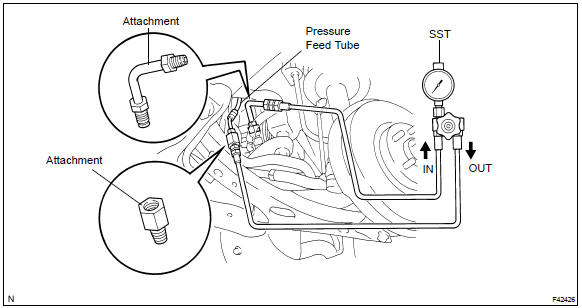
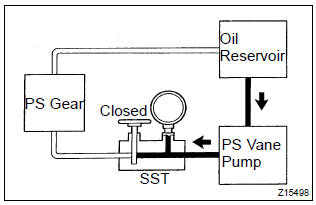
- With the engine idling, close the valve of the sst and observe
the reading on the sst.
Fluid pressure: 7,300 – 7,800 kpa (75 – 80 kgf/cm2, 1,067 – 1,138 psi)
Notice
:
- do not keep the valve closed for more than 10 seconds.
- Do not let the fluid temperature become too high.
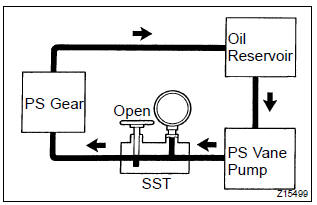
- With the engine idling, open the valve fully.
- measure the fluid pressure at engine speeds of 1,000 rpm
and 3,000 rpm.
Fluid pressure difference: 490 kpa (5 kgf/cm2, 71 psi) or less
Notice
: do not turn the steering wheel.

- With the engine idling and valve fully opened, turn
the
steering wheel to full lock position.
Fluid pressure: 7,300 – 7,800 kpa (75 – 80 kgf/cm2, 1,067 – 1,138 psi)
Notice
:
- do not maintain lock position for more than 10 seconds.
- Do not let the fluid temperature become too high.
- Disconnect the sst.
Sst 09640–10010 (09641–01010, 09641–01020, 09641–01030)
- connect the pressure feed tube to the ps gear .
- bleed the power steering system.
5. Check steering effort

- Center the steering wheel assy.
- remove the horn button assy .
- start the engine and run it at idle.
- measure the steering effort in both directions.
Steering effort (reference): 6 n·m (60 kgf·cm, 53 in.·Lbf) or less
Hint
: take the tire type, pressure and contact surface into consideration before making your diagnosis.
- install the steering wheel assy set nut.
Torque: 50 n·m (510 kgf·cm, 37 ft·lbf)
- install the horn button assy
Other materials:
Symptom confirmation and diagnostic trouble code
Hint:
the diagnostic system in corolla has various functions. The first
function is the diagnostic trouble
code (dtc) check, in which a malfunction in the signal circuits to the ecu
is stored in code form in
the ecu memory. Another function is the input signal check, which checks if
...
Manual transmission/transaxle
Preparation
Sst
Equipment
Lubricant
...
Amplifier antenna assy
Replacement
Hint: components:
Remove roof headlining assy
Notice:
do not bend the roof headlining assy.
Hint:
refer to the procedure from ”remove roof headlining assy” of roof
headlining assy.
Remove the related parts as long as the amplifier antenna assy can be
removed. ...


